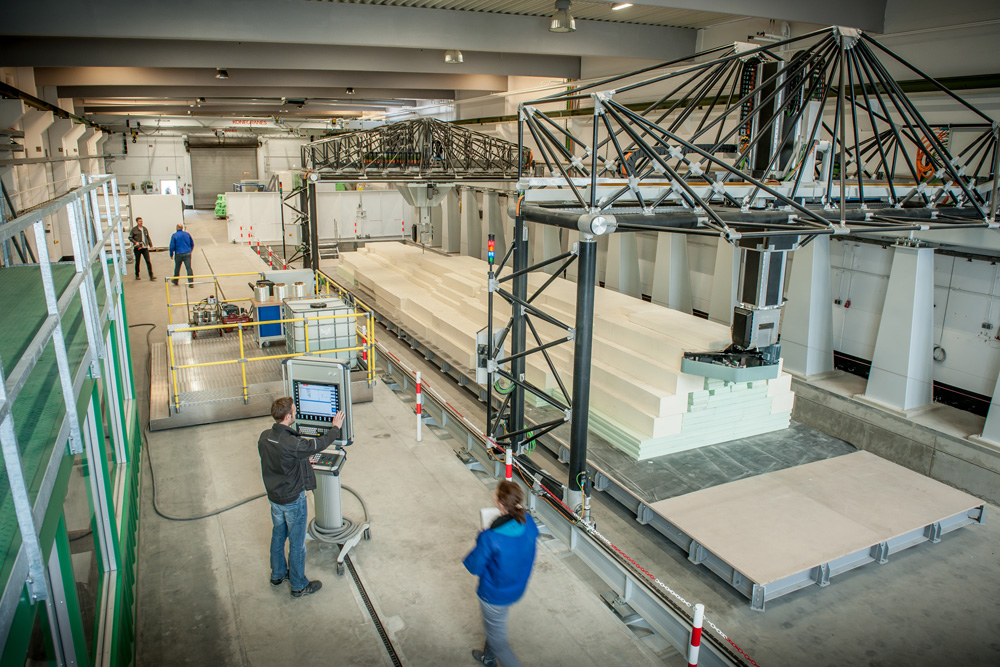
The two gantry robots made of fiber composite serve to frame the working area for blade sections. They move along the lines at a maximum speed of 2.5 m/s. A heavy-load platform for transporting the semi-finished products and materials is towed along the floor to facilitate the setting up of the gantry. The machine is programmed and operated via a CNC control, which, in this form, represents a new approach: The advantages of simple handling and vertical integration of design and production in order to simulate the process steps in advance can now be exploited for the very first time.
- 25 m (L), 4.35 m (W) and 2.3 m (H)
- Fits the root half of a 50 m blade
- 2 independent working gantry robots, moveable in 6 DOF
- Load-bearing capacity: 400 kg
- Speed: max. 2.5 m/s by accelerating with 4.5 m/s²
- 3,500 kg capacity for additional material and equipment
- Follows gantry system in longitudinal direction
- In preparation for the integration of 8 main process steps
- Fully Siemens NX CAD-CAM integration for offline programming and process simulation
In contrast to a purely automated approach,“BladeMaker” is focused on the industrialization of the entire process. In this context, new materials or the consistency of the semi-finished products have to be improved in order to open up further opportunities for reducing costs and manufacturing time. In addition to the direct tooling approach, Fraunhofer IWES has set up an innovative process chain together with specialized partners for the manufacturing of the rotor blade molds. Thanks to the special fiber composite gantry robots, various production steps, which would normally be conducted at different machines, can be performed at the same workstation by simply changing the process head.
The manufacturing of rotor blades still demands a high degree of manual labor. This is due to the low number of pieces in each production lot compared to the automotive industry for example: Whilst in the latter sector, models roll off the line hundreds of thousands of times, the tool mold for a rotor blade is only used as a template a few hundred times. Comparing the weight of components from blade and automotive production, the former are much heavier. Yet, for manufacturers, the ability to produce parts more quickly and with a constantly higher level of precision can result in significant cost advantages. Given the structural design of the former building, integration of the portal system presented no problems at all.
The equipment in the “BladeMaker Demonstration Center” is available to the blade industry as well as material suppliers and mechanical engineering companies. Based on the results of the generic cost model for rotor blade production, the main cost drivers have been identified. The production of the spar cap, positioning of the textile blanks for the root area in the mold through to alignment of the layers, innovative in-situ core concepts, direct infusion of the resin, application of the adhesive, and surface finishing to prepare for varnishing, all offer potential for cost savings.
TECHNICAL DATA
- Length: 18 m (root section to transition area of a 40 m blade)
- Design-Features: flatback, slender geometry
- Heating: electrical heating by integrated carbon fiber heating mats
- 3 heating zones
- max. temp. 120° C
- Length: 18 m (root section to transition area of a 40 m blade)
- Flat metal plate with convective heaters
- Heating capacity approximately up to 70° C
- Extendable with heating mats (except of the web feet)
- 2 webs out of 1 mould
BASF / EMG / EEW Protec / Faserinstitut Bremen / Fibretech composites / Fraunhofer IFAM / Fraunhofer IWES / Henkel / Hexion / PD Group / Schmalz / Siemens AG und Siemens Industry Software / Sinoi / University of Bremen - BIK / 2KM
- Federal Ministry for Economic Affairs and Energy: € 8 mio.
- Industry contribution: € 6 mio.
CONTACT
Fraunhofer IWES
This email address is being protected from spambots. You need JavaScript enabled to view it.
